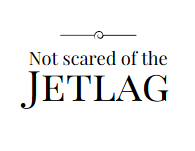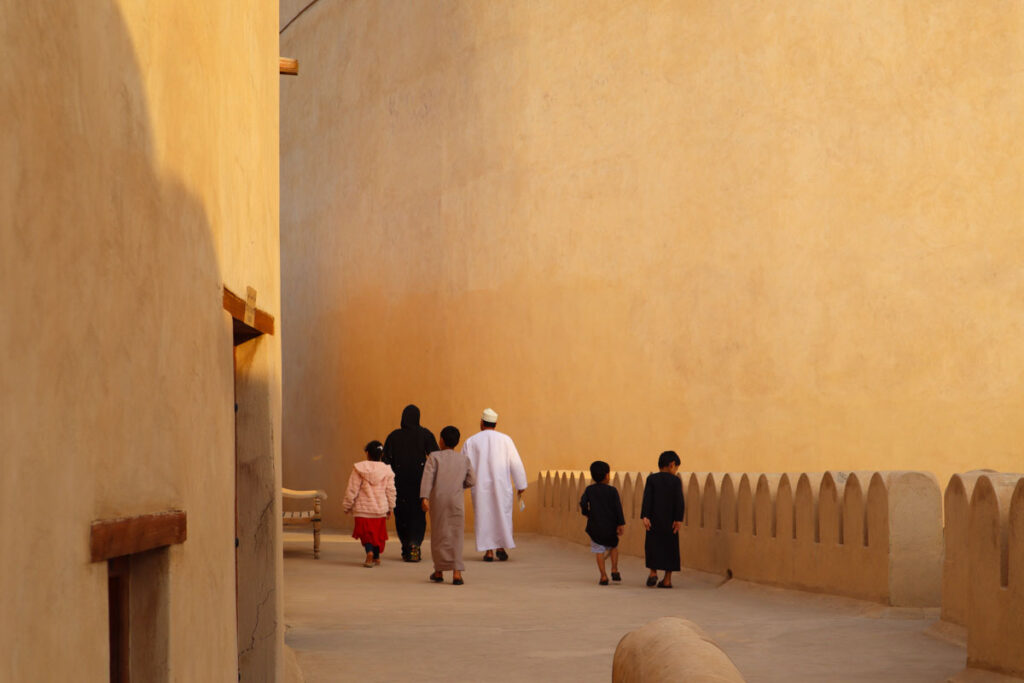Oman is my favourite country to visit in the whole world! I can’t even say why. It just calls me again and again. There are so many places to visit in Oman that even after spending a total of almost 5 weeks in the country, there is still much more for me to see.
The best thing about Oman though, and this is not listed in this article, are the people! They are so friendly and welcoming and a lot of them speak really good English.
Oman has a great mix of history and culture as well as nature to be attractive to everyone. And if you are still in doubt, if Oman is a place you should visit, keep reading this post. I am sure by the end you will book your flight!
The best places to visit in Oman around Muscat
Sultan Qaboos Grand Mosque
The Sultan Qaboos Grand Mosque is my favourite mosque and definitely a must-see attraction in Muscat. It is decorated in light colours and is surrounded by beautiful grounds and gardens. When I first visited it a few years ago, I was so impressed by the size, the beautiful gardens with frangipani trees and the tranquillity it exudes. I wanted to spend hours just walking around or sitting somewhere and letting time pass.
The main prayer hall can accommodate up to 6500 worshippers. It has one of the most intricate prayer rugs I have ever seen.
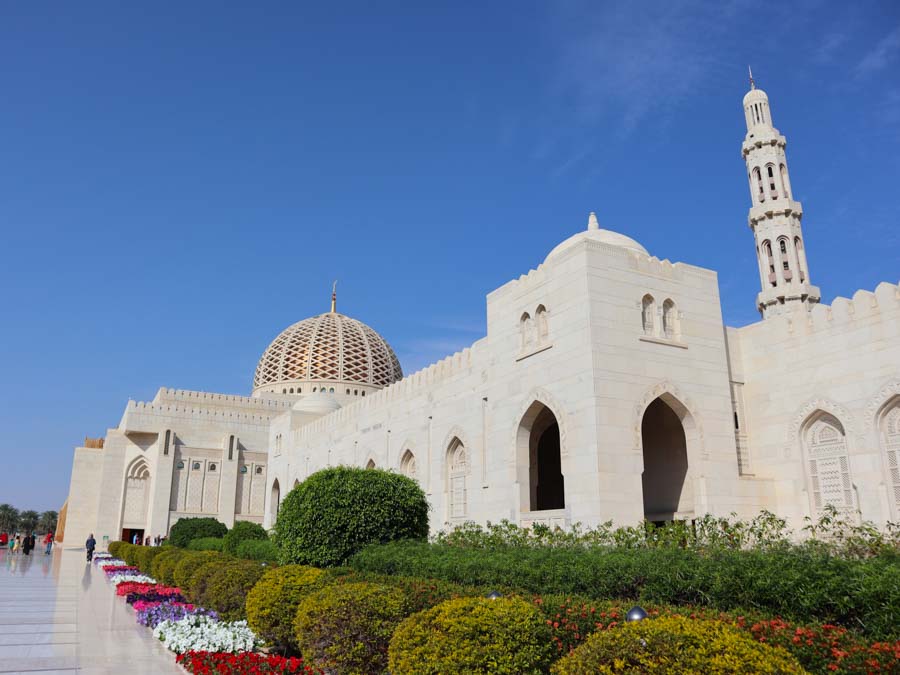
My favourite part of the complex is the mosaic gallery that surrounds the mosque. The long arcades on the north and south sides house niches with mosaics in different styles from all the Islamic countries. They are very beautiful and it is interesting to see the differences in Islamic art in the different regions.
Read this article if you are interested in other mosques to visit as a non-Muslim.
The Royal Opera House
The Royal Opera House has to be one of, if not THE most modern opera house in the world and should be on your list of places to visit in Muscat! Even if you’re not going to see an opera or a ballet, I highly recommend a tour of the building.
Opened in 2011, the opera house is mostly made of creamy white marble with intricate wooden details inside.The entrance hall is huge and has a beautiful grand staircase leading to the balconies. There are also display cases with costumes that were worn in performances.

The grand hall is full of technology. Depending on the type of performance, the stage can be extended by lowering the front rows of seats into the floor.The ceiling can be raised or lowered to change the acoustics for orchestra concerts. Even the small gallery balconies can be moved to accommodate the stage set-up.
Where to stay – Hotel tips for every budget:
Budget: Riyam Hotel in Muttrah
Medium: Sheraton
Luxury: W Muscat in Qurum or Shangri La Al Jissah Muscat a bit outside the city
Corniche of Muttrah
The corniche in Muttrah is best enjoyed at sunset as it doesn’t offer much shade. But it offers great views of the bay as well as the old town with its blue mosque. Walk on the water side in one direction and back on the other. This way you can admire the traditional buildings with their intricately decorated balconies and look at the small shops in between.

Muttrah Souk
The clear highlight of the sights in Muscat is the Muttrah Souk. Although it has been modernised in recent years, it still feels like you have travelled back in time. The small, crowded stalls are full of delicacies and souvenirs, from Omani halwa (a traditional sweet), to khanjars (the traditional Omani daggers), to pashmina shawls and cushion covers, and of course frankincense, the oldest Omani export.
Wondering what is a souk? Read more here!
Muttrah Fish Market
At the other end of the corniche, you will find the modern fish market hall. The waters around the coast of Muscat are teeming with fish, and here you can get a good look at them all. Get here early in the day to make the most of the experience.

Muttrah Fort
Muttrah Fort dates back to the early 16th century when Oman was occupied by the Portuguese. It is rather small, especially compared to the forts of Nizwa and Bahla.
It is nevertheless one of the best things to do in Muscat, if only for the view over the Muttrah Corniche.
Al Alam, the Royal Palace
The palace is a funny looking building, to be honest. Considering the Sultan’s wealth, it is a rather modest palace. It was completed in 1972 and is only one of several palaces in the country. You can walk towards the old fort in direction of the sea to catch a glimpse of the complex from the back as well.

National Museum of Oman
Opposite the palace is one of the most interesting places to visit in Oman. Exhibitions at the National Museum cover traditional dress, boat building and the history of seafaring, as well as other cultural aspects. Everything from prehistoric times to the present is covered.
You can find miniatures of forts around the country and many boat models of all sizes.
The best places to visit in Oman north of the Al Hajar Mountains
Wadi Dayqah Dam
The Wadi Dayqah Dam is one of the largest in the country and supplies the capital and other smaller towns with drinking water. There is a small park above the dam that families like to visit for picnics. It is also worth visiting the valleys in the vicinity and taking a short hike.
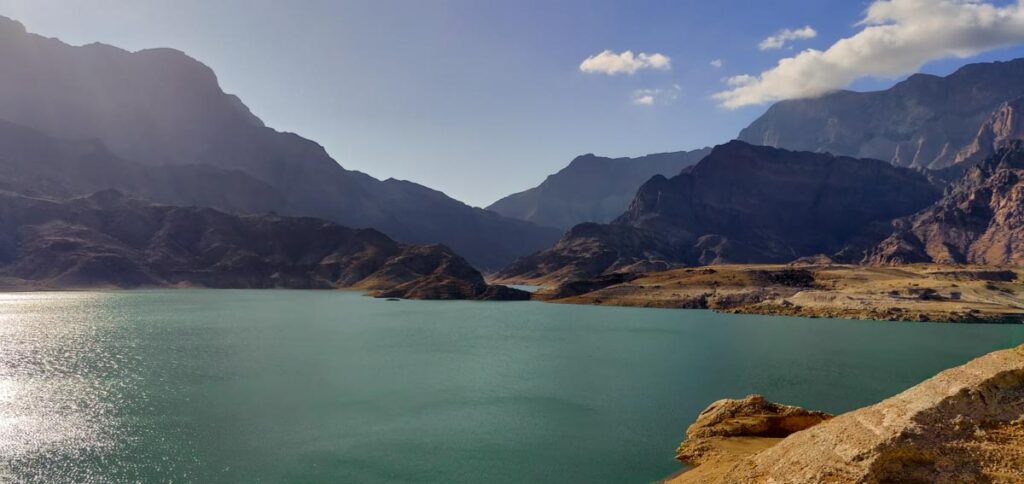
Wadi Shab
Wadi Shab is one of the most popular wadis in Oman. It is easily accessible by car via the highway from Muscat and almost all tour groups stop here.
To get to the wadi, you have to travel a short distance by boat from the car park (1 OMR). Then you walk for about 45 minutes in the beautiful, green Wadi Shab, always along the river. There are several pools along the way where you can swim. At the end of the trail you can swim for about 20 minutes further upstream to a waterfall in a cave. When I was there, however, the water level was too high and the cave entrance was under water.

Bimmah Sinkhole
Another popular destination in Oman is the Bimmah Sinkhole. Here the ground has collapsed almost circular and a lake has formed at the bottom. You can reach the bottom via a staircase and are also allowed to swim here.
The area has been fenced off for several years and a small park has been created.

Sur
Sur is a relatively untouristy harbour town with an impressive dhow shipyard. Dhows are the traditional wooden boats that the Omanis once used to travel to Zanzibar and other places. They are still made by hand today. There is also a small museum nearby that exhibits various models and their history.
There is a lighthouse and fort on the east side of the harbour entrance, from which you have a great view of the city.

Ras Al Jinz Turtle Reserve
This is definitely one of the most unique things to do in Oman. The Ras Al Jinz Turtle Reserve is located at the easternmost point of Oman. You can book tours here to watch turtles laying eggs on the beach, or if you’re lucky, baby turtles hatching. It is possible to stay overnight directly in the building.
Where to stay – Hotel tips for every budget:
Budget: Turtle Guest House
Medium: Ras Al Jinz Turtle Reserve
Musandam
If you are looking for an off the beaten path experience in Oman, this is your best bet. The Musandam Peninsula is an extremely barren, rocky headland that can be reached by plane to Khasab, by boat, or by car via the UAE. The most beautiful experience is going on a multi-day tour with a dhow. You can see the fjords from different perspectives, go on day hikes into the mountains and you are practically guaranteed to see dolphins coming to the ship.
The best places to visit in Oman in the Al Hajar Mountains
Misfat Al Abriyyin
Misfat Al Abriyyin is famous for being a place where you can observe the traditional life of the Omanis. Unfortunately, this is no longer the case. Too many tourists have not respected the privacy of the locals, taking pictures of the women, for example. And now most people have moved to new houses on the other side of the valley.
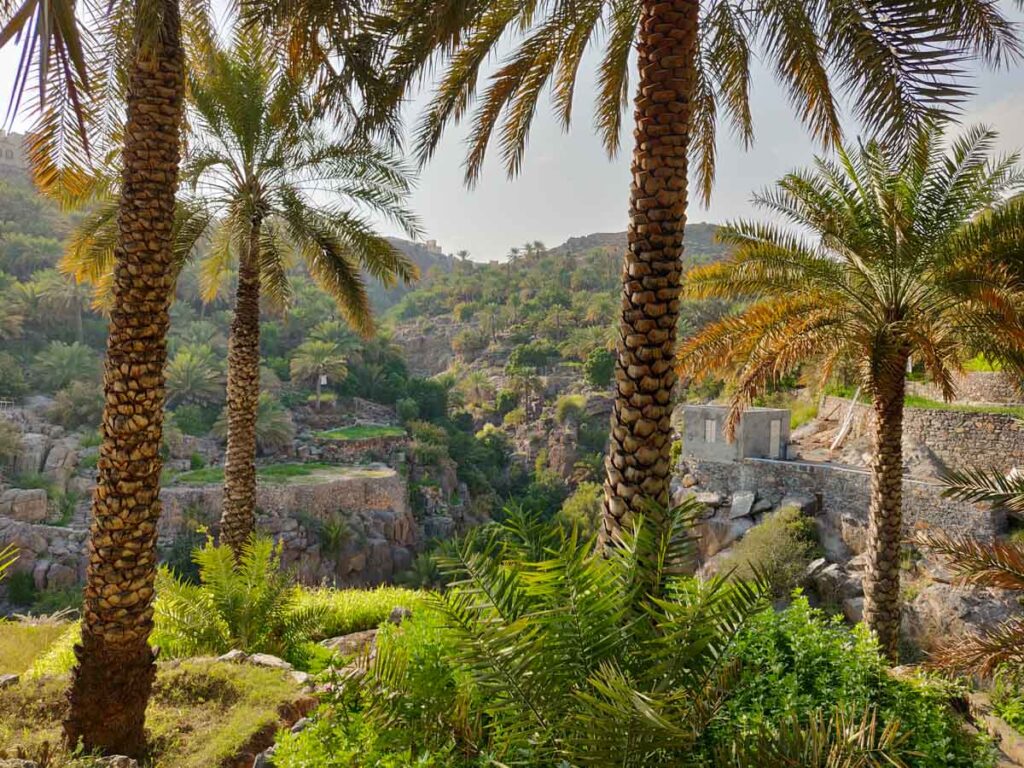
What remains is a ghost town with the old, very beautiful mud houses, narrow alleys and a few guesthouses. You can visit the public bathhouse and there is a beautiful short walk between the orchards down into the valley (and up again on the other side). The trail starts at Misfah Old House, which I would recommend for an overnight stay here.
Where to stay – Hotel tip: Misfah Old House
Jebel Shams
Jebel Shams, the Sun Mountain, is the highest mountain in Oman at just over 3000m. The summit is military territory, but you can get to the second highest point a bit off the beaten track. The road there is still gravel for the last few kilometres, so if you don’t have an off-road vehicle, you have to drive very slowly.
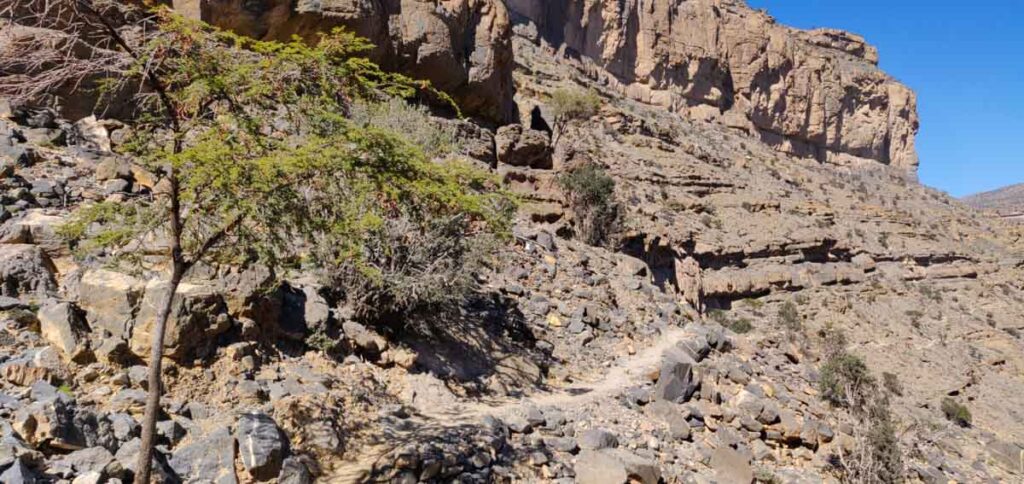
In my opinion, the Balcony Walk (marked in the maps.me app) on the opposite side of Wadi Ghul is much more interesting than the summit. Follow the road to Jebel Shams Resort to the end, to the village of Al Khitayam. Here, behind the women selling handmade jewellery, you will find the path that runs along Oman’s “Grand Canyon”.
You should be free from vertigo, as the path leads along the steep slope to a few old houses and a hidden waterhole. If it has rained lately, there is also a waterfall.
Jebel Akhdar
Jebel Akhdar, the Green Mountain, is Oman’s orchard. Terraces have been created in the numerous valleys and mainly fruit trees have been planted. That is why the fruit blossom in spring is a popular time to visit.

The most famous viewpoint was named “Diana’s Point” after Lady Di. To get there, you have to walk through the very fancy and expensive Anantara Resort, but no one there minds.
My favourite place to visit in the Jebel Akhdar region was Bani Habib, a remote valley with a small clay village.
Where to stay – Hotel tips for every budget:
Medium: Sama Hotel Jabal al Akhdar
Luxury: Anantara al Jabal al Akhdar Resort or Alila Jabal Akhdar
Wadi Bani Khalid
The second very well-known wadi is Wadi Bani Khalid. In contrast to Wadi Shab, however, it resembles more a water park than a natural paradise. After a few metres from the car park, you reach a landscaped park with restaurants and a few pools that almost look like they have been built.
If you walk a little further up the valley, you will find more pools that are much less frequented. If you search a little, you will also find one or two entry points. This is where the true beauty of Wadi Bani Khalid is found.
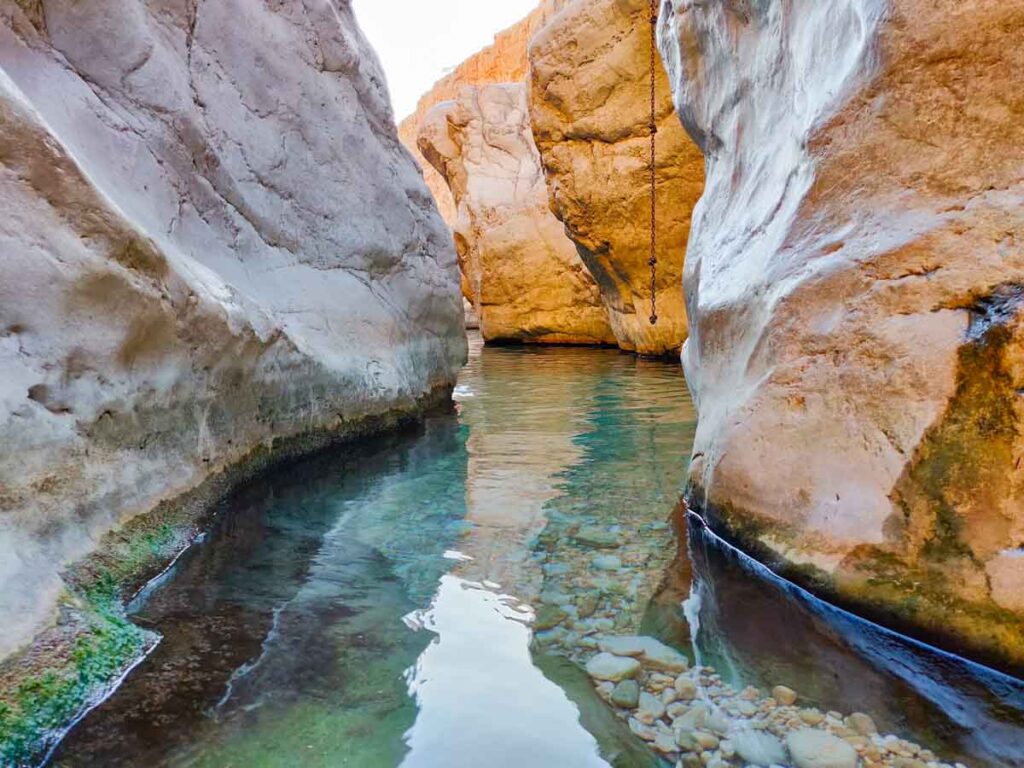
Snake Canyon
Snake Canyon (Wadi Bimah) is a great destination for real adventurers. However, as there have been accidents with fatalities here in the past, you should only go into the canyon with a licensed local guide. There can always be flash floods, even if no rain has fallen in the immediate vicinity.
There are some offers for canyoning, but for me it was too cold in January to spend a day in the water. We camped nearby and the surrounding valleys are also really worth seeing.
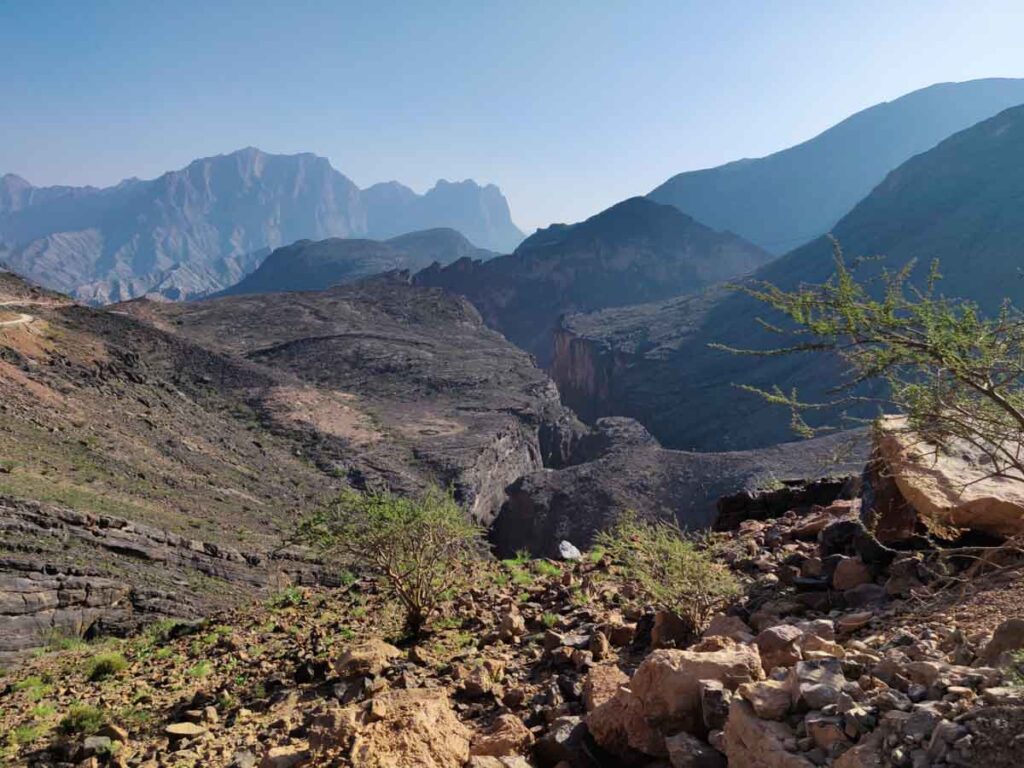
The best places to visit in Oman south of the Al Hajar Mountains
Nizwa
In the 6th and 7th century Nizwa was the capital of Oman. Today Nizwa is famous for the old fort and the souk and a great place to visit in Oman.
The souk is especially interesting on Fridays when sheep and goats are presented and sold. Otherwise, you can find everything from everyday items to food and handicrafts. The region is famous for its dates, which you should definitely try here.
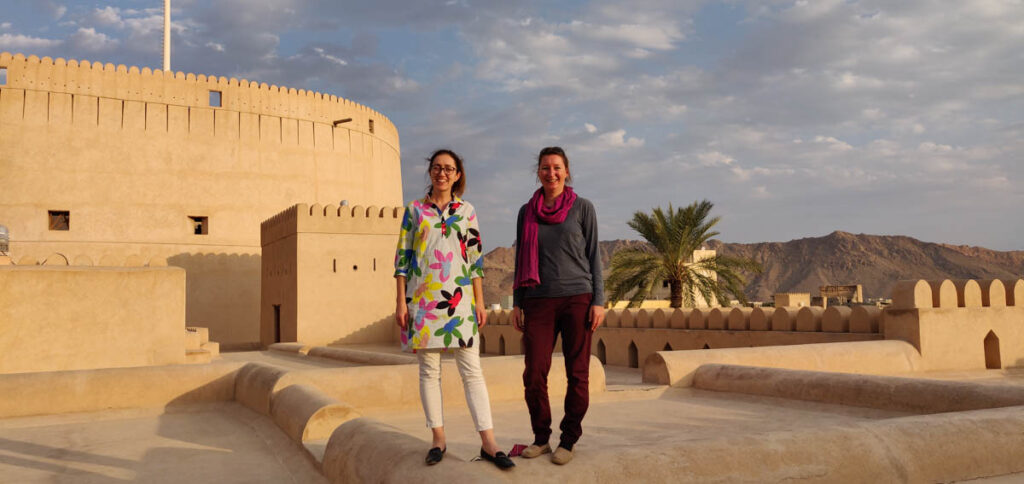
The Nizwa fort was built around 1670 and is one of the most important in the country. Here you can see very impressively the defence mechanisms that were used at that time.
Where to stay – Hotel tips for every budget:
Budget: Antique Inn
Medium: Mud House Nizwa, a very special, traditional house, not suitable for tall people, sadly
Luxury: Bustan Inn
Wahiba Sands
The Wahiba Desert is an area of sand dunes measuring approximately 180 x 80 km. Most visitors book one (or more) nights in a permanent camp. The choice here ranges from simple to super luxurious. If you have a rental car with 4×4 drive, you can drive yourself to the camp, but if you are unsure, you can also have someone pick you up.
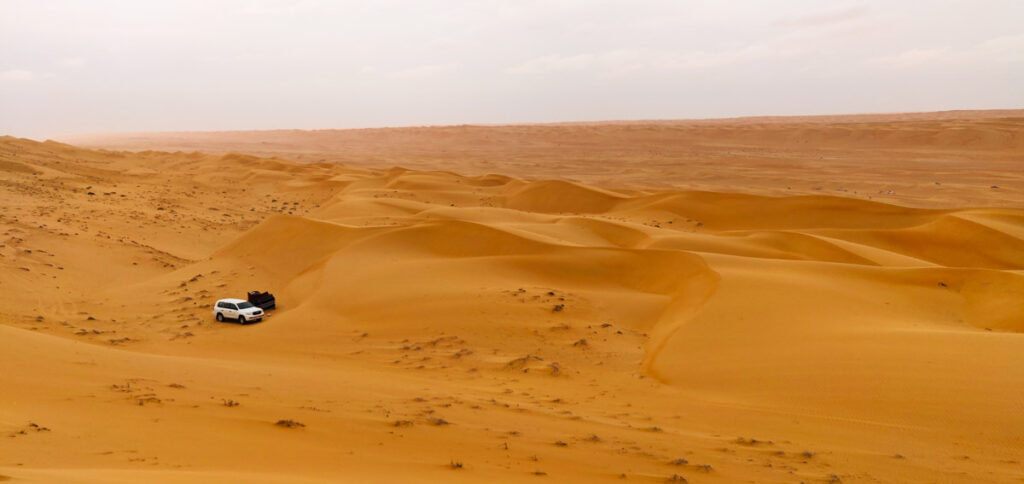
It is worth climbing the highest dune in the vicinity at sunset or sunrise. The view is a dream! You can also book camel rides here and feel like Lawrence of Arabia.
Al Ayn Beehive Tombs
The beehive tombs of Al Ayn are over 4000 years old. Together with other Bronze Age monuments in the region, they are a UNESCO World Heritage Site. You can see the tombs from the road and when we were there you could just walk up to them. There was no fence and you didn’t have to pay an entrance fee.
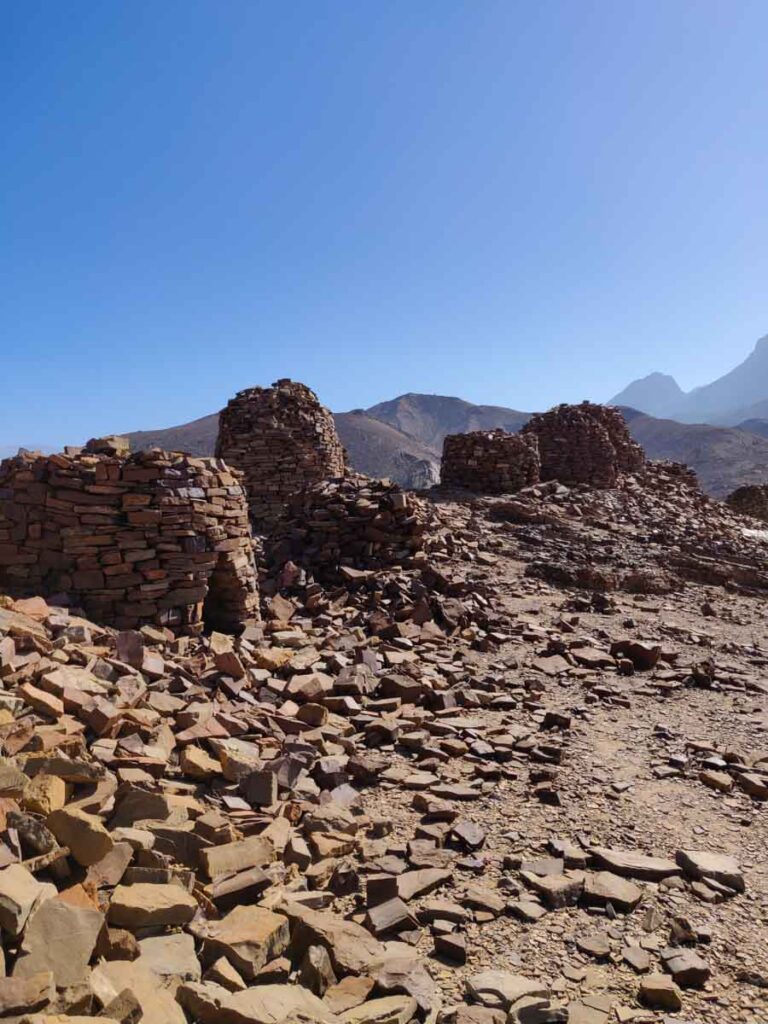
Bahla Fort
Another UNESCO World Heritage Site is Bahla Fort. It was built between the 12th and 15th centuries and is likely one of the largest forts in Oman. One can imagine that in times of crisis the town could be almost completely housed inside the fort. You can easily spend a few hours here to see everything.
Stables, living quarters, a mosque, a hammam and so much more. From the upper floors you also have a great view over the fort and the town.
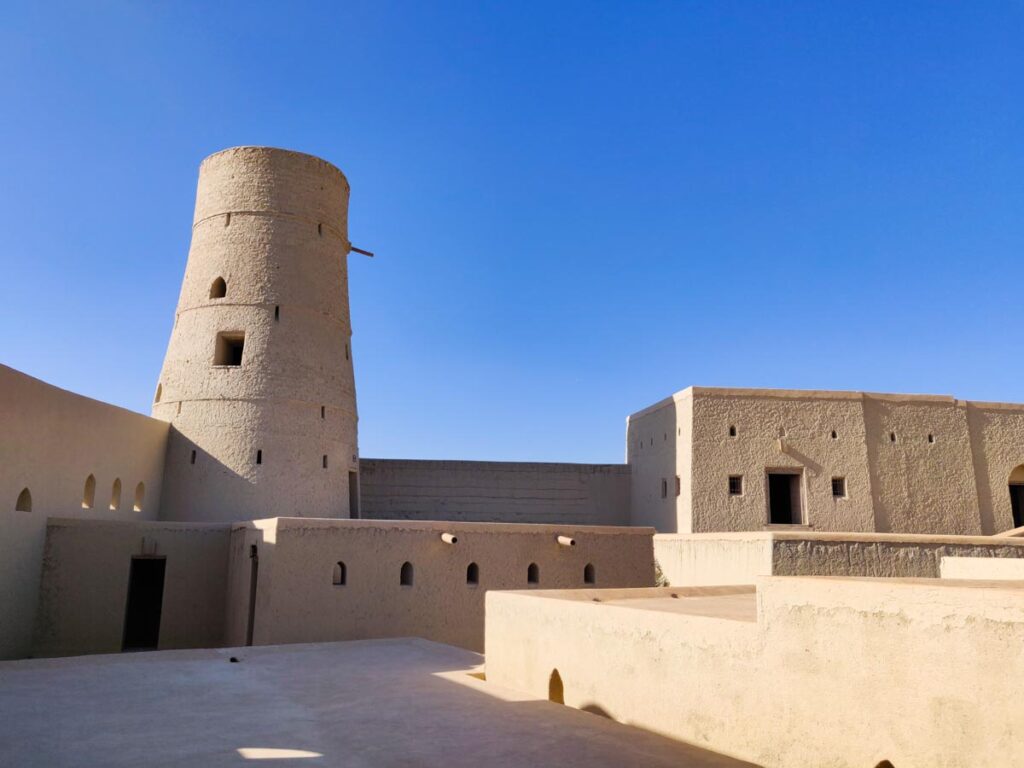
Jabreen Castle
Jabreen Castle was built in the 17th century and was definitely a highlight of my Oman trip. There is a very good audio guide with which you can explore the castle on your own, at your own pace. The “Sun and Moon Room” with its painted ceiling and the “Date Preservation Room” were particularly interesting.
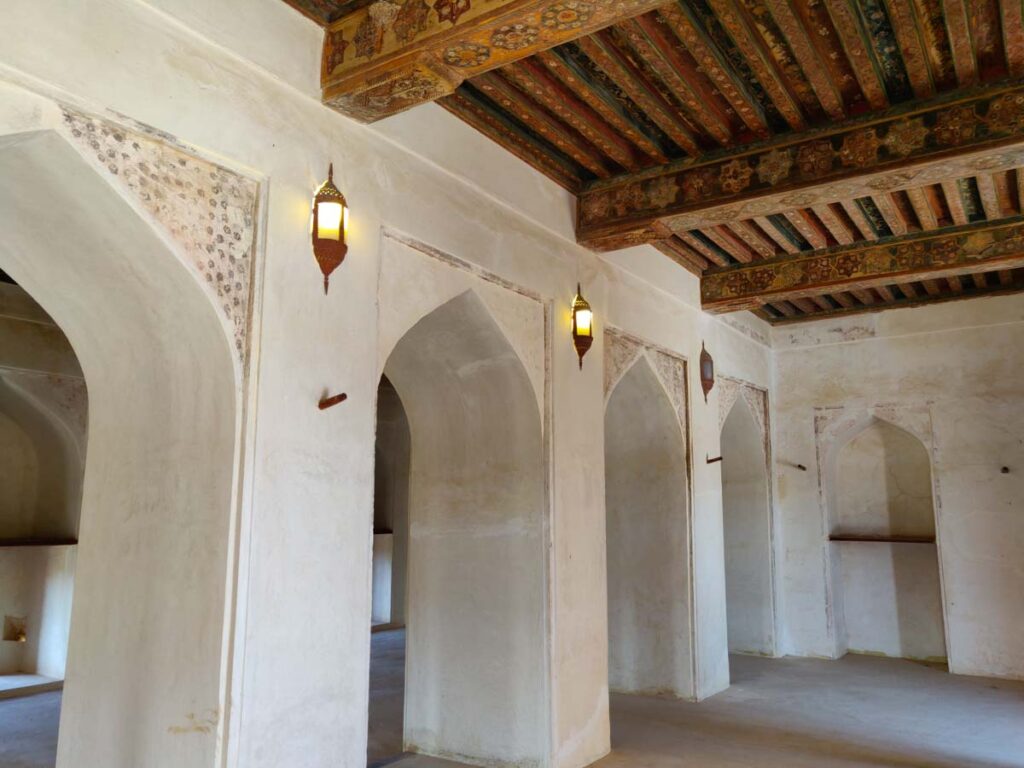
The best places to visit in Oman in the far South
Salalah
Salalah is a rather unspectacular coastal city in the south of Oman. A visit here is really only worthwhile in connection with a desert tour to the Rub Al Khali or during the rainy season, when the surrounding mountains green up for a few weeks and the waterfalls and rivers have plenty of water.
Where to stay – Hotel tips for every budget:
Medium: Crowne Plaza Resort Salalah at the beach or Muscat International Hotel Plaza Salalah in the centre
Rub al Khali
The largest sand desert in the world, the Rub Al Khali, is impressive. The long sand dunes stretch for dozens of kilometres and are separated from each other by shallow valleys. Especially at sunset the dunes glow a spectacular red, which is rarely seen in other deserts.
I did a 9-day desert hike here years ago, but compared to the other deserts I visited, the Rub Al Khali was rather monotonous.
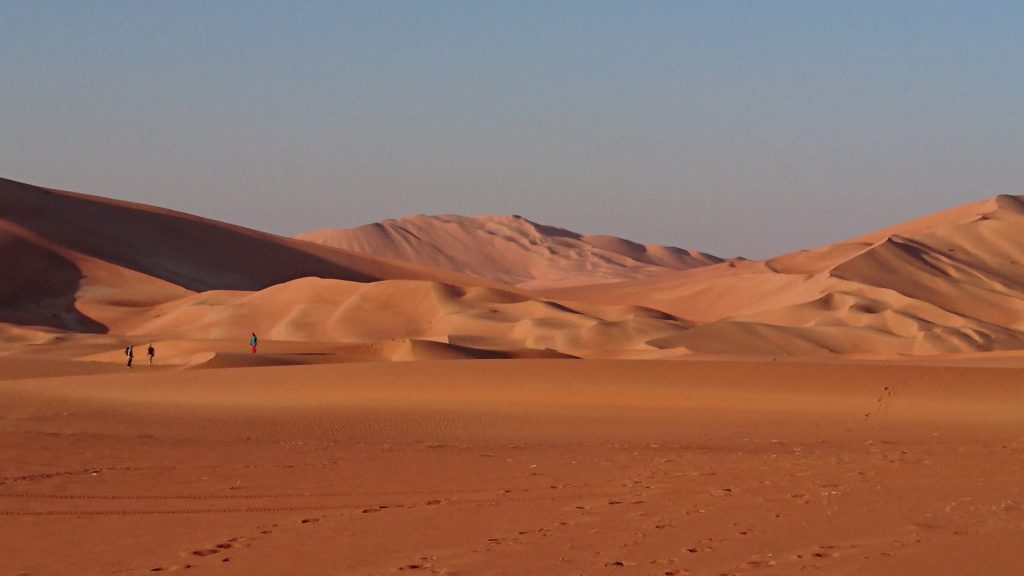
Please note that some of the links above are affiliate links and, at no additional cost to you, I earn a small commission if you make a purchase. That income goes to supporting this website and keeping it free for you and everyone else!
